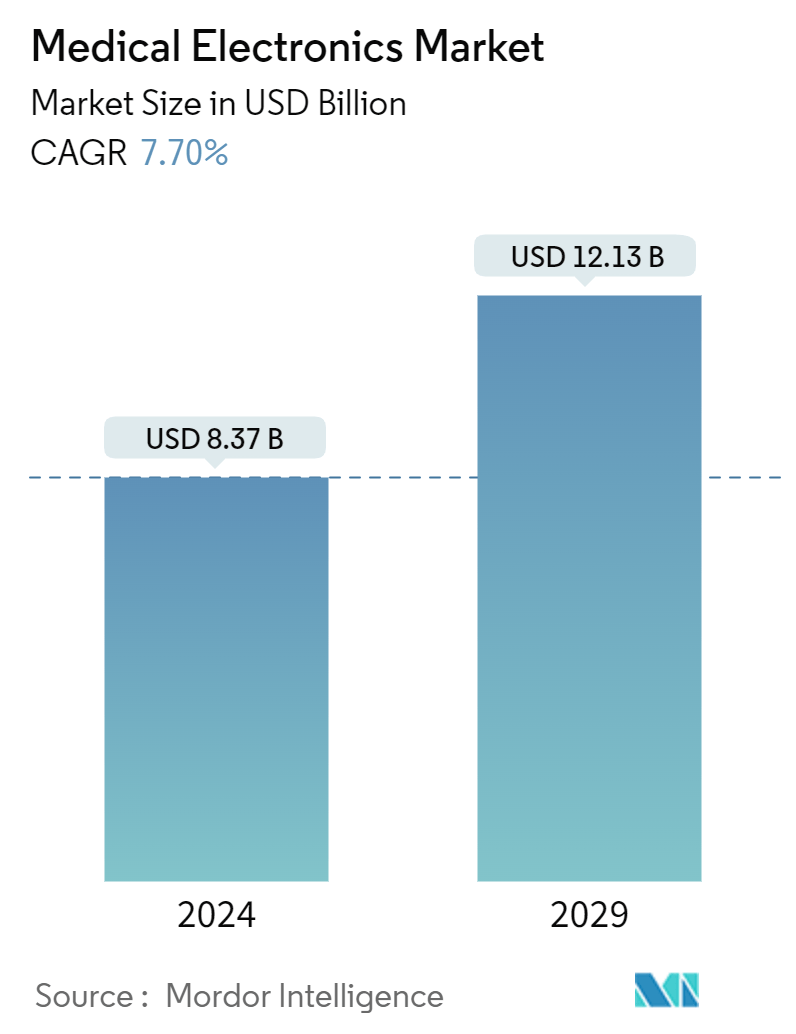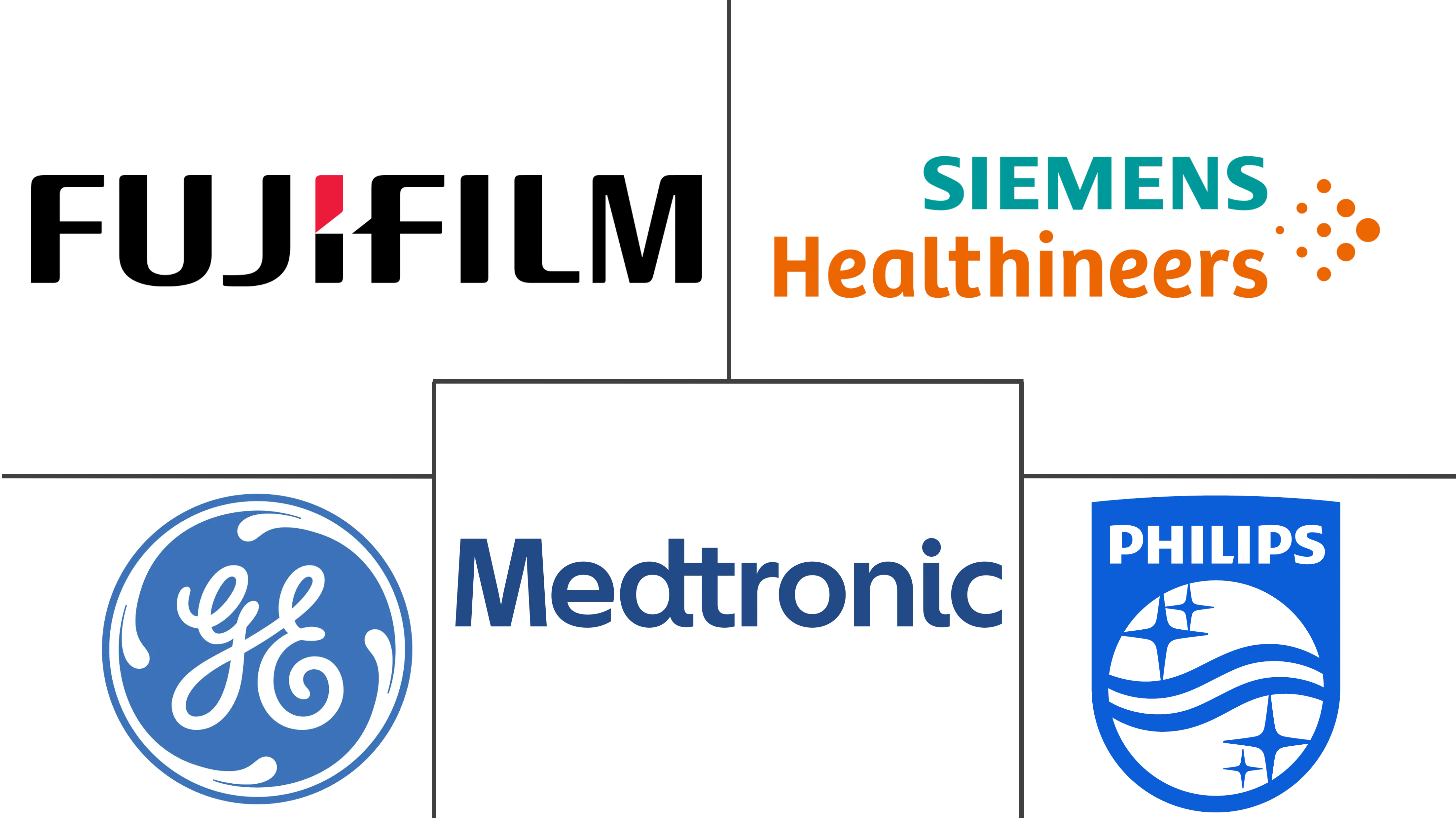Market Size of Medical Electronics Industry

| Study Period | 2019 - 2029 |
| Market Size (2024) | USD 8.37 Billion |
| Market Size (2029) | USD 12.13 Billion |
| CAGR (2024 - 2029) | 7.70 % |
| Fastest Growing Market | Asia Pacific |
| Largest Market | North America |
Major Players
*Disclaimer: Major Players sorted in no particular order |
Medical Electronics Market Analysis
The Medical Electronics Market size is estimated at USD 8.37 billion in 2024, and is expected to reach USD 12.13 billion by 2029, growing at a CAGR of 7.70% during the forecast period (2024-2029).
COVID-19 impacted the medical electronics market initially. The decrease in imaging volumes during the pandemic affected the growth pace of the market in the preliminary phase. For instance, an article published in the Journal of the American College of Radiology in July 2021, reported that the total imaging volume in 2020 (weeks 1-16) declined by 12.29% as compared to the previous year. It also reported that post-COVID-19 (weeks 10-16) revealed a greater decrease (28.10%) in imaging volumes across all patient service locations. The same source also reported that an 88% decline was seen at week 16 in outpatient imaging, and MRI contributed to a nearly 74% decline. Such a decline in volumes due to the pandemic has impacted market growth amid the outbreak. However, the demand for patient monitoring devices greatly increased during the pandemic period as they allowed contactless communication and tracking of medical conditions by clinicians. Moreover, the application of x-ray imaging for the diagnosis and treatment of COVID-19 and associated diseases has positively impacted the market's growth in the latter phase of the pandemic. For instance, from an article published in BMC Pulmonary Medicine Journal, in June 2021, it has been observed that a chest x-ray was used to diagnose and follow up patients with COVID-19 pneumonia. Thus, with the relaxed restrictions, resumed diagnosis and treatment services, and the high adoption of medical imaging equipment, the demand for medical electronics has increased in the post-pandemic phase, and as per the analysis, the market is expected to regain its full potential in the next two to three years.
The factors such as the rising incidence and prevalence of chronic diseases coupled with the increasing geriatric population and the growing application of imaging devices.
The increasing burden of chronic diseases such as cancer, neurological diseases, cardiovascular diseases, respiratory diseases, and others are the key factor driving the market growth. For instance, according to the 2022 statistics published by the IDF, about 537 million adults aged between 20-79 were living with diabetes globally, and this number is projected to increase to 643 million and 783 million by 2030 and 2045, respectively. Thus, the higher number of diabetic and obese people increases the risk of developing other chronic diseases such as coronary artery disease, hypertension, and stroke, which increases the need for early detection as well as regular monitoring of the heart condition. This is anticipated to fuel market growth over the forecast period.
Additionally, as per data published in the Alzheimer's Association 2022 report, more than 1.5 million people in Germany were suffering from Alzheimer's disease, and this number is expected to double by 2050. This is anticipated to increase the need to early detect the brain abnormalities associated with mild cognitive impairment as well as understand the neuropathological mechanisms. This is further expected to fuel the demand for MRI and CET scan testing, thereby bolstering the market growth.
Aging results from accumulating a wide variety of molecular and cellular damage over time, leading to a gradual decrease in physical and mental capacity and a growing risk of disease. Common conditions in older age include back and neck pain and osteoarthritis, chronic obstructive pulmonary diseases, heart diseases, cancer, and others. For instance, according to the March 2022 update of the Australian Bureau of Statistics, the prevalence of heart disease in Australia was 4.0% in 2020-2021, which equates to about 1 million people. Also, as per the same source, in Australia, heart disease increased with age, from 2.3% of people aged 45-54 years through to 23.2% of people aged 75 years and over, with males being the most affected by it in the country. Since the older population is prone to the disease, it is expected to generate the need for medical electronics for diagnosis, thereby driving the market's growth.
Furthermore, rising product launches and approvals are also expected to increase market growth over the forecast period. For instance, in March 2022, Rapid Response Revival launched CellAED, one of the first personal, portable defibrillators that use sophisticated technology designed to improve the chances of surviving a sudden cardiac arrest, in the United Kingdom.
Moreover, the increasing government funding, as well as rising company activities for developing advanced products, are also contributing to the market growth. For instance, in July 2021, a new magnetic resonance imaging (MRI) scanner facility opened in Leicester, worth EUR 3.1 billion (USD 3.28 billion). This new facility increases the current imaging capacity of researchers from 500 cardiovascular research participants a year to 1,500. The new scanner facility has been funded by a EUR 1 million (USD 1.1 million) grant from the BHF. It will be jointly owned by Leicester's Hospitals, which has dedicated EUR 2.1 million (USD 2.2 million) to the facility, and the University of Leicester.
Therefore, owing to the aforementioned factors, the studied market is expected to grow over the forecast period. However, the strict regulations for device approval and the high cost of maintenance of the devices are expected to hinder the growth of the medical electronics market over the forecast period.
Medical Electronics Industry Segmentation
As per the scope of the report, medical electronics is an electronics division that deals with the design, installation, and use of electrical appliances and equipment for medical applications such as study, monitoring, treatment, diagnosis, assistance, and care. The market is segmented by Product (Non-Invasive Products (MRI, X-Ray, CT Scan, Ultrasound, Nuclear Imaging Systems, Cardiac Monitors, Respiratory Monitors, Hemodynamic Monitors, Multipara Monitors, Digital Thermometers, and Other Products) and Invasive Products (Endoscopes, Pacemakers, Implantable Cardioverter Defibrillator (ICD), Implantable Loop Recorders, Spinal Cord Stimulator and Other Invasive Products), Application (Diagnostics, Monitoring, and Therapeutics), End User (Hospitals and Clinics, Ambulatory Surgical Centers, and Other End Users), and Geography (North America, Europe, Asia-Pacific, Middle-East and Africa, and South America). The market report also covers the estimated market sizes and trends for 17 countries across major regions globally. The report offers the value (in USD million) for the above segments.
| By Product | |||||||||||||
| |||||||||||||
|
| By Application | |
| Diagnostics | |
| Monitoring | |
| Therapeutics |
| By End User | |
| Hospitals and Clinics | |
| Ambulatory Surgical Centers | |
| Other End Users |
| Geography | ||||||||
| ||||||||
| ||||||||
| ||||||||
| ||||||||
|
Medical Electronics Market Size Summary
The medical electronics market is poised for significant growth, driven by the increasing prevalence of chronic diseases and the aging population. The market experienced initial setbacks due to the COVID-19 pandemic, which led to a decline in imaging volumes. However, the demand for patient monitoring devices surged during this period, and the use of imaging technologies for COVID-19 diagnosis and treatment provided a boost to the market. As restrictions eased and healthcare services resumed, the market began to recover, with expectations of regaining its full potential in the coming years. The rising incidence of conditions such as diabetes, cardiovascular diseases, and neurological disorders is fueling the need for advanced medical electronics, including imaging devices, to facilitate early detection and regular monitoring.
North America is anticipated to lead the market, supported by a robust healthcare infrastructure, high healthcare spending, and the adoption of advanced technologies. The region's growing burden of chronic diseases, such as arthritis and cancer, is driving the demand for medical electronics that aid in early diagnosis and treatment. The market is characterized by intense competition, with major players like Medtronic, GE Healthcare, and Siemens Healthcare actively engaging in product launches, acquisitions, and partnerships to strengthen their market positions. The introduction of innovative products and the increasing focus on minimally invasive therapies are expected to further propel market growth over the forecast period.
Medical Electronics Market Size - Table of Contents
-
1. MARKET DYNAMICS
-
1.1 Market Overview
-
1.2 Market Drivers
-
1.2.1 Increasing Geriatric Population
-
1.2.2 Rising Application of Imaging Devices
-
-
1.3 Market Restraints
-
1.3.1 Ramped up regulatory scrutiny
-
1.3.2 High Cost and Maintenance
-
-
1.4 Porter's Five Forces Analysis
-
1.4.1 Threat of New Entrants
-
1.4.2 Bargaining Power of Buyers/Consumers
-
1.4.3 Bargaining Power of Suppliers
-
1.4.4 Threat of Substitute Products
-
1.4.5 Intensity of Competitive Rivalry
-
-
-
2. MARKET SEGMENTATION (Market Size by Value - USD million)
-
2.1 By Product
-
2.1.1 Non-invasive Products
-
2.1.1.1 MRI
-
2.1.1.2 X-Ray
-
2.1.1.3 CT Scan
-
2.1.1.4 Ultrasound
-
2.1.1.5 Nuclear Imaging Systems
-
2.1.1.6 Cardiac Monitors
-
2.1.1.7 Respiratory Monitors
-
2.1.1.8 Hemodynamic Monitors
-
2.1.1.9 Multipara Monitors
-
2.1.1.10 Digital Thermometers
-
2.1.1.11 Other Products
-
-
2.1.2 Invasive Products
-
2.1.2.1 Endoscopes
-
2.1.2.2 Pacemakers
-
2.1.2.3 Implantable Cardioverter Defibrillator (ICD)
-
2.1.2.4 Implantable Loop Recorders
-
2.1.2.5 Spinal Cord Stimulator
-
2.1.2.6 Other Invasive Products
-
-
-
2.2 By Application
-
2.2.1 Diagnostics
-
2.2.2 Monitoring
-
2.2.3 Therapeutics
-
-
2.3 By End User
-
2.3.1 Hospitals and Clinics
-
2.3.2 Ambulatory Surgical Centers
-
2.3.3 Other End Users
-
-
2.4 Geography
-
2.4.1 North America
-
2.4.1.1 United States
-
2.4.1.2 Canada
-
2.4.1.3 Mexico
-
-
2.4.2 Europe
-
2.4.2.1 Germany
-
2.4.2.2 United Kingdom
-
2.4.2.3 France
-
2.4.2.4 Italy
-
2.4.2.5 Spain
-
2.4.2.6 Rest of Europe
-
-
2.4.3 Asia-Pacific
-
2.4.3.1 China
-
2.4.3.2 Japan
-
2.4.3.3 India
-
2.4.3.4 Australia
-
2.4.3.5 South Korea
-
2.4.3.6 Rest of Asia-Pacific
-
-
2.4.4 Middle-East and Africa
-
2.4.4.1 GCC
-
2.4.4.2 South Africa
-
2.4.4.3 Rest of Middle-East and Africa
-
-
2.4.5 South America
-
2.4.5.1 Brazil
-
2.4.5.2 Argentina
-
2.4.5.3 Rest of South America
-
-
-
Medical Electronics Market Size FAQs
How big is the Medical Electronics Market?
The Medical Electronics Market size is expected to reach USD 8.37 billion in 2024 and grow at a CAGR of 7.70% to reach USD 12.13 billion by 2029.
What is the current Medical Electronics Market size?
In 2024, the Medical Electronics Market size is expected to reach USD 8.37 billion.

